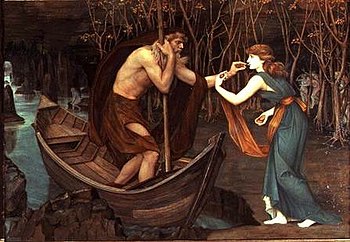
Charon's obol is an allusive term for the coin placed in or on the mouth[1] of a dead person before burial. Greek and Latin literary sources specify the coin as an obol, and explain it as a payment or bribe for Charon, the ferryman who conveyed souls across the river that divided the world of the living from the world of the dead. Archaeological examples of these coins, of various denominations in practice, have been called "the most famous grave goods from antiquity."[2]
The custom is primarily associated with the ancient Greeks and Romans, though it is also found in the ancient Near East. In Western Europe, a similar usage of coins in burials occurs in regions inhabited by Celts of the Gallo-Roman, Hispano-Roman and Romano-British cultures, and among the Germanic peoples of late antiquity and the early Christian era, with sporadic examples into the early 20th century.
Although archaeology shows that the myth reflects an actual custom, the placement of coins with the dead was neither pervasive nor confined to a single coin in the deceased's mouth.[3] In many burials, inscribed metal-leaf tablets or exonumia take the place of the coin, or gold-foil crosses during the early Christian period. The presence of coins or a coin-hoard in Germanic ship-burials suggests an analogous concept.[4]
The phrase "Charon's obol" as used by archaeologists sometimes can be understood as referring to a particular religious rite, but often serves as a kind of shorthand for coinage as grave goods presumed to further the deceased's passage into the afterlife.[5] In Latin, Charon's obol sometimes is called a viaticum, or "sustenance for the journey"; the placement of the coin on the mouth has been explained also as a seal to protect the deceased's soul or to prevent it from returning.
- ^ Neither ancient literary sources nor archaeological finds indicate that the ritual of Charon's obol explains the modern-era custom of placing a pair of coins on the eyes of the deceased, nor is the single coin said to have been placed under the tongue. See "Coins on the eyes?" below.
- ^ Ian Morris, Death-ritual and Social Structure in Classical Antiquity (Cambridge University Press, 1992), p. 106 online.
- ^ Gregory Grabka, "Christian Viaticum: A Study of Its Cultural Background," Traditio 9 (1953), 1–43, especially p. 8; Susan T. Stevens, "Charon’s Obol and Other Coins in Ancient Funerary Practice," Phoenix 45 (1991) 215–229.
- ^ Discussed under "Archaeological evidence".
- ^ Morris, Death-ritual and Social Structure in Classical Antiquity, p. 106, noting in his skeptical discussion of "Who Pays the Ferryman?" that "coins may have paid the ferryman, but that is not all that they did." See also Keld Grinder-Hansen, "Charon’s Fee in Ancient Greece?" Acta Hyperborea 3 (1991), p. 215, who goes so far as to assert that "there is very little evidence in favour of a connection between the Charon myth and the death-coin practice", but the point is primarily that the term "Charon’s obol" belongs to the discourse of myth and literature rather than the discipline of archaeology.